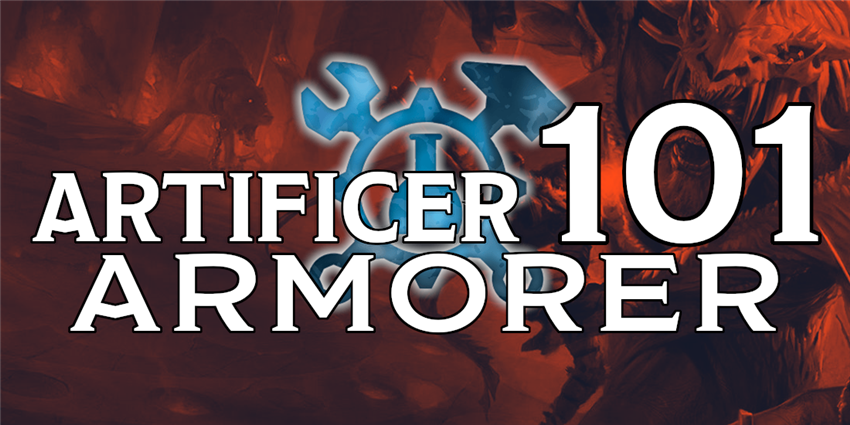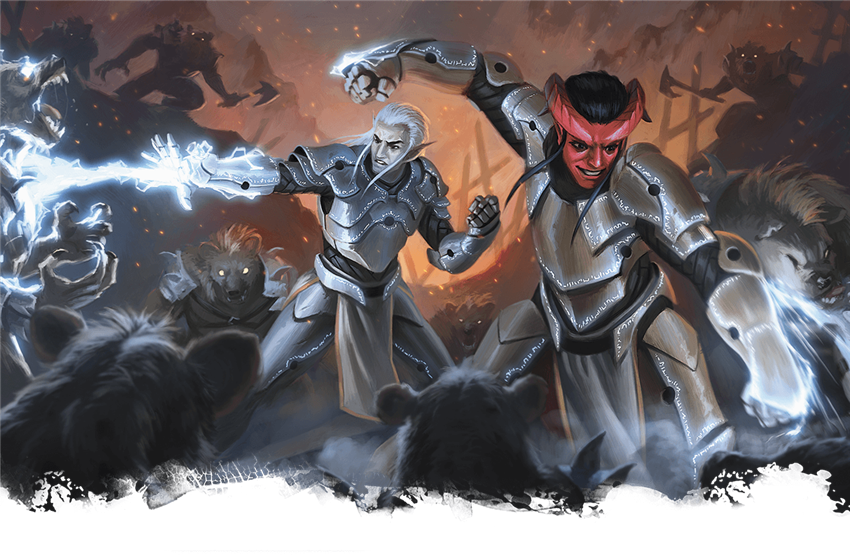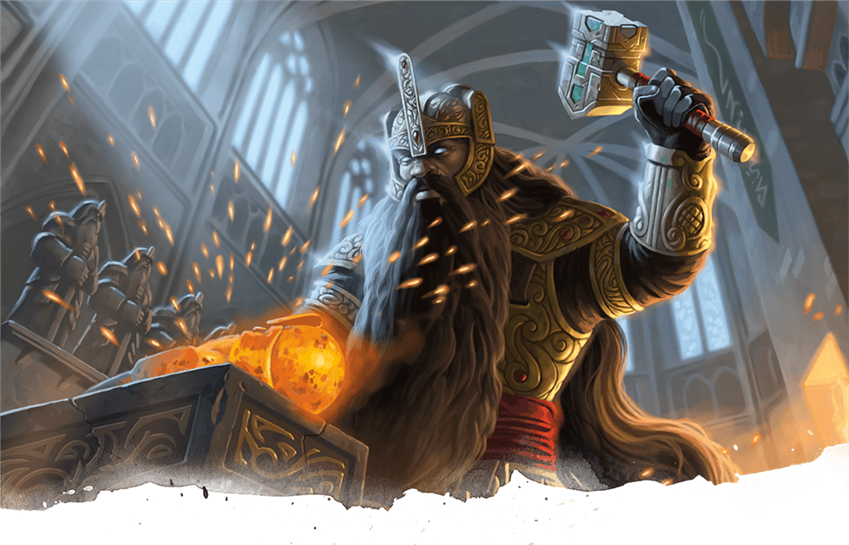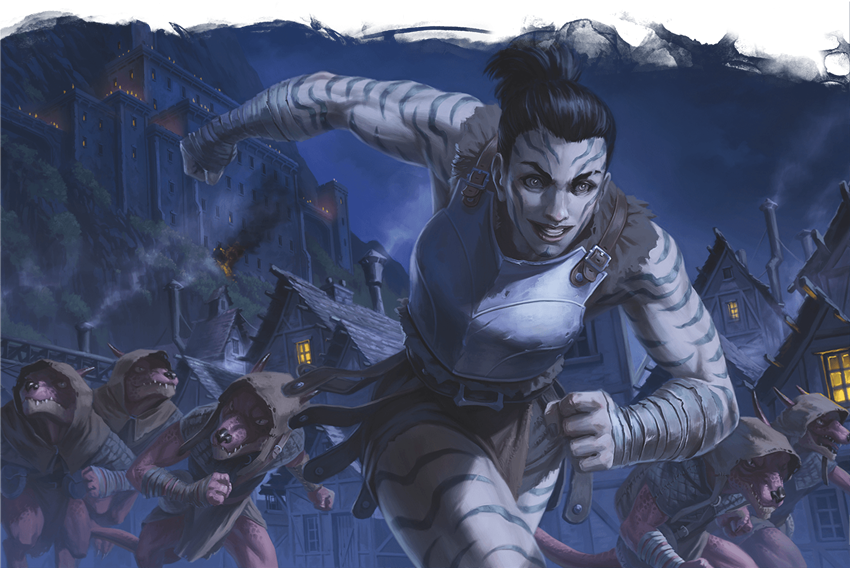We’ve now completed a third rotation of the Player’s Handbook, meaning that almost every class has had every subclass from that book examined in the Class 101 series! Two classes with lots of subclasses—the cleric and wizard—will need a little extra time to cover. Starting this week, however, we’re moving away from the Player’s Handbook and taking a look at the brand-new subclasses that you’ll find in Tasha’s Cauldron of Everything!
The first new subclass from Tasha’s is also from the game’s newest class: the artificer. This subclass, the Armorer, is a favorite of both Todd Kenreck and myself, because of the way they straddle the line of fantasy and science fiction with their magical power armor.
Artificers are most common in the world of Eberron, as described in Eberron: Rising from the Last War. However, artificers of some sort can be found all throughout the D&D multiverse. You can find artificers in the Forgotten Realms on the isle of Lantan, among the gnomes of Hupperdook in Wildemount, and filling all levels of prestige within the ranks of the Izzet League on the world-city of Ravnica—just to name a few settings where artificers can be found. If you’re playing D&D in another world or in a homebrew setting, talk with your Dungeon Master about how you could integrate artificers into this world.
Check out the other guides in the Class 101 series, like the broad overview of the artificer class in Artificer 101: A Beginner’s Guide to Making Magical Marvels, or a deep dive into a specific subclass in Artificer 101: Alchemist. If you’re interested in playing other classes, check out the entire Class 101 series.
Story of the Armorer
“And that is the Mark 1 Guardian.” A half-orc dressed in oil-covered clothing whistled in awe. Her hair was pulled into a high ponytail and her biceps glistened under the light of the forge. She turned to the hobgoblin beside her, who looked on in awe at the suit of steel plate armor that hung on the wall before them both. “I’m afraid it’s for personal use only. Not for sale.”
“Your pièce de résistance?” the hobgoblin replied gruffly.
“My masterpiece,” the armorer replied proudly. “But I’m not so precious to think that it’s perfect. You can see that I haven’t bothered polishing it.” Just as she said, the armor was rough, unfinished, and unpolished. By its appearance, it hardly befitted the title of masterpiece.
“My warriors care little for polish,” the hobgoblin said guilelessly. “We are interested in strength and durability. You can provide both?”
The half-orc armorer laughed. “In spades, my friend. My apprentices and I can supply you with armor that will suit your mercenary company’s needs, but you deserve something better, don’t you? Would you care for a demonstration? I can’t promise you something quite as good as the Mark 1, but you’ll see that my armor is made of more than just steel.”
The hobgoblin barked out a jagged laugh. “A claim I’ve heard a hundred times. Go on, armorer, prove the worth of your steel!”
A smile crossed the armorer’s face, just wide enough for one of her stubby tusks to pop out from behind her lips. She strode across the room and placed her hand on the chest piece of her Mark 1 Guardian. Its plates shuddered at her touch, then sprung to life and rolled down her arm like an army of dully glinting beetles. In seconds, there was a click as the metal plates which had slithered over her body snapped into place. The tiny runes engraved around the edges of each plate glowed with faint white light, and her heavy gauntlets thrummed with barely restrained thunder.
The armorer reached to a weapon rack and tossed a longsword to the hobgoblin, who caught it deftly, even taken by surprise. His mouth hung slightly agape, and his eyes darted up and down the half-orc’s armored body, drinking in the details of her handiwork. She set her feet in a fighting stance and pointed her open palms at the hobgoblin, causing a faint pulse of rumbling magic to hum through the air between them.
“Is this demonstration enough, sir?” she asked cheekily. “Or would you prefer to test the Guardian’s might yourself?”
The hobgoblin laughed again, this time with complete, unchecked mirth. He set the sword down upon a bench and held his hands over his shoulders. “I yield, armorer! You are no charlatan, I trust that your steel is honest. Are you certain your Guardian is not for sale?”
The half-orc shook her head. “It’s bonded to me, sir. It wouldn’t be more than a suit of ill-fitting plate mail on the shoulders of another.”
“Then…” the hobgoblin turned to the armorer slyly. “Perhaps I can make an offer for your armor with you still in it. There are tasks too dangerous even for my mercenaries to take on—if you would be willing to leave your forge, we could use an adventurer. My pockets are deep, armorer.”
Armorer Features
Armorers are artificers who have specialized in the craft of armor smithing. Like any good artificer, they don’t simply make armor, they make miracles. The artificer gains four subclass features at 3rd, 5th, 9th, and 15th level. You can read all of the Alchemist specialty features in Tasha’s Cauldron of Everything. In summary, your subclass features allow you to:
- Become proficient with smith’s tools
- Learn new spells thematically appropriate for an armorer
- Create a suit of arcane armor that only you can wear, gaining special powers if it’s in its Guardian or Infiltrator form
- Attack more than once per turn, making you a more dangerous fighter
- Infuse the individual components of your Arcane Armor with magic
- Perfect your Guardian and Infiltrator armor models

Benefits of the Armorer
The Armorer subclass lets the artificer take on a surprising role in combat: the role of tank! No one would expect the artificer, a class that is by all accounts a fantasy scientist, to be able to step out onto the battlefield, hollering for all blades to be turned upon them, yet this is exactly what the Armorer artificer is able to do with the Guardian model of their Arcane Armor. Better yet, they aren’t pigeonholed into the tank role. After a short rest, the Armorer can retool their Arcane Armor into the sleek and stealthy Infiltrator model, allowing them to slink quickly through the shadows.
Notably, both armor models let you do something that few other classes can do. The Guardian model’s Thunder Gauntlets allow you to “taunt” foes when you hit them, encouraging them to attack you by imposing disadvantage on that creature’s attacks against other foes. To improve your survivability, it also allows you to gain a surge of temporary hit points to mitigate incoming damage.
All of the Armorer’s class features either synergize with both armor models, or specifically improve one of them. For instance, the Extra Attack feature is useful for striking multiple targets with the Guardian model’s Thunder Gauntlets, thus “taunting” more foes. While it’s less useful on the Infiltrator model, having another attack makes it more likely for you to hit at least once with your Lightning Launcher, which gets bonus damage once per turn.
Taken together, this bevy of powerful and versatile features transform you into a terror on the battlefield, while still wielding an artificer’s spells and the ability to infuse your allies’ items with magic to support them in whatever dangerous situations you might face.

Drawbacks of the Armorer
The Armorer is a powerful subclass, but that power comes at a price. The most significant price is the price of paperwork. The Armorer’s 9th-level feature, Armor Modifications, lets you enchant your Arcane Armor in an incredibly granular way. This feature separates your armor into segments, each of which can be infused separately. This is a substantial boost to your power, and D&D Beyond’s digital character sheets will help you keep track of all your features, but you still have to do the work of deciding how to allocate your infusions—and more importantly, re-allocate your infusions whenever you want to change up which infused items you have available to you.
This leads to the most significant drawback of the Armorer subclass: a tradeoff between personal power and team support. The Armorer is one of the most self-sufficient artificer subclasses in the game. However, a hallmark feature of the artificer is their ability to infuse items with magic, not just for their own use, but for their allies’ use. Similarly, other subclasses have a number of spells and class features that encourage artificers to support their allies, rather than becoming the center of attention themselves. The Armorer subclass isn’t without these features—the Guardian model Arcane Armor is one of the best tanking tools in D&D—but it vastly minimizes party support in favor of personal power. If you want to play a support character, this isn’t the subclass for you.

Suggested Build
As an artificer, you choose what kind of Artificer Specialist you want to be at 3rd level. This gives you time to figure out what sort of role you want to fill in the party. If you decide that you want be a flexible character who can tank blows for their allies one encounter and slip unseen into the shadows the next, Armorer is custom-fitted for your needs. To learn about the other roles the artificer class can fill, check out Artificer 101: A Beginner’s Guide to Making Magical Marvels.
All artificers need a keen intellect in order to be effective. As such, prioritize making your Intelligence score as high as possible. Even though you’ll often be striking foes with your fists, your magical Thunder Gauntlets allows you to add your Intelligence modifier, rather than your Strength modifier, to attack and damage rolls. Beyond that, it’s useful to improve your Dexterity and Constitution scores to improve your somewhat meager hit points, and to improve your AC if you decide to wear medium armor rather than heavy armor.
An Armorer should place their highest ability score in Intelligence and their second-highest in either Dexterity or Constitution, depending on whether you think stealth or tanking is more important to you. Thanks to the new “Customizing Your Origin” section in Tasha’s Cauldron of Everything, you don’t have to let your character’s race dictate their ability scores; you can reassign your racial ability score bonuses to any score you see fit. If you’re playing without these rules, the rock gnome and high elf races grant useful bonuses to Intelligence and other useful abilities, plus other mechanical bonuses. However, the best way to create a character is to choose the race suits your character best, and build outward from there.
Choose EQUIPMENT instead of GOLD at the end of character creation. Your two simple weapons can be anything that you think fits your character’s aesthetic. You still have to grow from 1st to 3rd level before you choose your Armorer subclass, so your starting equipment doesn’t have to perfectly match what you want your character to wear when they master the craft of armoring. Choose scale mail for a solid defense—one that you can turn into your Arcane Armor later if you don’t find anything better on your adventures in the interim. Choosing a set of thieves’ tools will make infiltrating locations with your Infiltrator model armor much easier!

Spells
You prepare your spells, just like a cleric or druid. At the end of every long rest, you can prepare a number of spells from the artificer spell list, and can use your spell slots to cast these prepared spells in any combination. When you prepare spells, you can choose a number of artificer spells equal to your Intelligence modifier + half your artificer level, rounded down (minimum of one spell). You also start play with two cantrips, also chosen from the artificer spell list. These cantrips are 0-level spells that you can cast an unlimited number of times per day.
As an Armorer, you’ll want at least two spells marked DEFENSE, one spell marked OFFENSE, and one spell marked either SUPPORT, SOCIAL or UTILITY, depending on how you want to play your character.
- Absorb elements (DEFENSE/OFFENSE)
- Catapult (OFFENSE)
- Cure wounds (SUPPORT)
- Detect magic (UTILITY)
- Disguise self (SOCIAL)
- Faerie fire (SUPPORT)
- Feather fall (UTILITY)
- Grease (DEFENSE)
- Sanctuary (DEFENSE/SUPPORT)
Infusions
 Starting at 2nd level, you’ll be able to infuse items with magical power, turning them into something greater than what they were before. At 2nd level, you know four different infusions, and can have two of them active at a time. The infusions you pick should be largely based not on your build, but the composition of your party. What infusions do they need to be more powerful? Every time a party member does something awesome with an infused item you’ve given them, that’s a win for both of you.
Starting at 2nd level, you’ll be able to infuse items with magical power, turning them into something greater than what they were before. At 2nd level, you know four different infusions, and can have two of them active at a time. The infusions you pick should be largely based not on your build, but the composition of your party. What infusions do they need to be more powerful? Every time a party member does something awesome with an infused item you’ve given them, that’s a win for both of you.
You learn four infusions at 2nd level, and can replace any infusion you know with another one whenever you gain a level. The infusions available to you at 2nd level are:
Enhanced Arcane Focus. For parties with spellcasters in it. Even though you usually use your artificer's tools as a spellcasting focus, you can benefit from this infusion as well—since any item you create can be used as a spellcasting focus!
Enhanced Defense. For parties with heavily armored allies. You can use this one yourself, if enemies have been focusing you down lately!
Enhanced Weapon. A broadly useful infusion for parties with damage-dealing powerhouses in it.
Homunculus Servant. For the artificer who needs a little helping hand, you create a tiny creature that can deal a little bit of damage in combat, but is mostly useful for helping you as a conduit for your spells.
Repeating Shot. For parties with ranged attackers. You can empower a ranged weapon with a magical bonus to attack and damage, and grant it the ability to conjure and load its own ammunition!

Feats
Once you’ve improved your Intelligence score to 18 or 20, you can increase your power with a few useful feats. The following feats are good picks for Armorer artificers, and will improve your reliability in your own desired area of expertise:
Eldritch Adept. Using this new feat from Tasha’s Cauldron of Everything, you can infuse your artificer with a bit of a warlock’s unsettling magic. Choosing the invocations like Mask of Many Faces and Devil's Sight makes you a more potent infiltrator. The only question is…where does this power come from?
Heavy Armor Master. If you plan on tanking in heavy armor, this damage-reducing feat is a useful one for you, especially due to your relatively low hit points.
Mobile. Tanks like to rush into combat and attract the attention of many foes at once. Sneaks like to move quickly and quietly. Since you have the power of both these roles, Mobile is almost always going to be useful for you!
Sentinel. There simply isn’t a better feat for a tank to take. Be sure to take this if you plan on tanking a lot for your party.
Shadow Touched. This new feat from Tasha’s Cauldron of Everything tinges your artificer with the gloom of the Shadowfell—a useful gift to have for anyone who wants to make excellent use of their Infiltrator model armor.
Tough. Plan on taking lots of damage to spare your party from being hurt? Then it would be smart to pick up a few extra hit points.
If you want more advice for building an artificer, check out Artificer 101. Have you ever played an Armorer artificer? What advice would you give to players that want to play this subclass? Join us next week as we dive deep into the contents of Tasha's Cauldron of Everything with Barbarian 101: Path of the Beast!
Create A Brand-New Adventurer Acquire New Powers and Adventures Browse All Your D&D Content
 James Haeck is the lead writer for D&D Beyond, the co-author of Waterdeep: Dragon Heist, Baldur's Gate: Descent into Avernus, and the Critical Role Explorer's Guide to Wildemount, a member of the Guild Adepts, and a freelance writer for Wizards of the Coast, the D&D Adventurers League, and other RPG companies. He lives in Seattle, Washington with his fiancée Hannah and their animal companions Mei and Marzipan. You can find him wasting time on Twitter at @jamesjhaeck.
James Haeck is the lead writer for D&D Beyond, the co-author of Waterdeep: Dragon Heist, Baldur's Gate: Descent into Avernus, and the Critical Role Explorer's Guide to Wildemount, a member of the Guild Adepts, and a freelance writer for Wizards of the Coast, the D&D Adventurers League, and other RPG companies. He lives in Seattle, Washington with his fiancée Hannah and their animal companions Mei and Marzipan. You can find him wasting time on Twitter at @jamesjhaeck.











-
View User Profile
-
Send Message
Posted Dec 7, 2020D&D doesn't have to be the heroic fantasy/sword and sorcery medieval-ish archetype they present in the core rulebooks. Hell, they've got laser guns and assault rifles in the DM's guide. In fact, my DM is working on a cyberpunk style campaign now, using nothing but the core rules. If you use your imagination, (which is half the point of the game) theme doesn't matter.
-
View User Profile
-
Send Message
Posted Dec 7, 2020The icewindale module has those in it...
-
View User Profile
-
Send Message
Posted Dec 8, 2020-
View User Profile
-
Send Message
Posted Dec 8, 2020(I think your quoting went weird somewhere there; I think I've fixed it in this post but I might have been wrong about where you started.)
Okay, so while I actually agree with you about Psionics and I loved the dice wackiness of the UA Psionic system, I really strongly disagree that the Armorer is inappropriate for D&D worlds as a whole. It doesn't have to be remotely hi-tech for starters, and (in my opinion) it fits the ideal of "Magic Craftsman" far better than a sci-fi superhero.
Would you accept a wizard-dropout with a magic coat of plates that can Sorcerer's Apprentice onto their body, sending arcane lightning through a cobbled-together crystalline focus?
Perhaps instead a nature-themed outlander, with blood-marked hides that channel the bellows of beast-spirits through every strike to defend the pack?
How about the young scion of elemental air, studying their storm-touched heritage and channelling sorcerous blood through iron chains rather than letting it act on whim?
The gifted and cunning mage-knight, deciding to unite arcana with shining armour rather than taking the predictable path of the spellsword.
The disabled hero-to-be who swore to one day match a monk in strength and speed; taking the path of intellect where naïve willpower failed, they build the perfect body.
The pious music-lover who wishes to hear the toll of the old cathedral bell every time they strike the barbaric hordes that shattered it, wearing armour forged from its wreckage.
The occult master, discovering bits and pieces of ancient planar armaments from battles holy and heretical, cobbling-together a true marvel of ages past.
All of these are off the top of my head and fit pretty well in a number of D&D settings; none of them require you to be any more of a scientist than your typical fantasy smith or wizard, and one of them isn't even working with metal!* Indeed, magic armour and animated armour have always been a thing in the hobby; is the "traditional game" really so marred by the adventuring presence of the folks who actually built the darn things? If so, how on earth did it cope with the entire alignment plane populated nigh-exclusively by robots?
I get that the flavour can seem a little incongruous, but most of that isn't actually in the subclass. People want to be Iron Man, sure, but people have wanted to be Iron Man since before D&D was a thing, and the subclass itself serves many more fantasies than that one. The living golem, the false paladin, the mithril ballgown, the 'magical girl', the Weyland, the Hephaestus, the cataphract, the stage magician, the bombastic boxer, the wannabe stone/storm giant... So on, so forth, etc. Do truly none of those fit into your D&D?
No judgement if not. Just... it seems counter-productive to dislike an option this much based on the idea of what it is rather than what you can do with it. If you're DMing you can choose not to allow it, and if you're playing you can choose not to play it.
----
* The smith's tools requirement, while a little weird, is pretty meaningless when tinker's tools (which are generally for mending and odd-jobs, not gadgeteering) can give you any craftsman's kit you darn well please.
-
View User Profile
-
Send Message
Posted Dec 8, 2020I think it's a little unfair that these guys are limited to smith's tools to make arcane armor. It makes for some pretty interesting designs if you use weaver's, leatherworkers, or even things like tinker's or woodcarver's tools to do this.
-
View User Profile
-
Send Message
Posted Dec 8, 2020Great subclass. Too bad you can't use any of their features or traits since you can't get them on your character sheet on this site. It's been almost a year, and still there is no way to use the mechanics of this class in D&D Beyond. Sad.......
-
View User Profile
-
Send Message
Posted Dec 8, 2020-
View User Profile
-
Send Message
Posted Dec 8, 2020Hey folks, thanks for all your discussion regarding Two-Weapon Fighting and the Armorer's Thunder Gauntlets. Because there's no clear answer right now, I've opted to remove the Dual Wielding suggestion from this 101 guide—despite how I would rule it in my own games. Cheers!
-
View User Profile
-
Send Message
Posted Dec 9, 2020Could kept it up with that explained! It honestly seems like a vocal minority thinks it doesnt work Duel wielder was added as a feat long before such weapons like thunder gauntlets existed and dual wielder is the last squeeze of damage you can get out of the subclass!
-
View User Profile
-
Send Message
Posted Dec 9, 2020Almost a year? Its been like two weeks for the features I listed. Infusions are now active atleast. The rest will come in time that they have managed to deal with the big Ranger problems
-
View User Profile
-
Send Message
Posted Dec 9, 2020This class was on D&D Beyond when it was a UA class. Plenty of time time to fix the same bugs it had then
-
View User Profile
-
Send Message
Posted Dec 9, 2020Why is it the people that disagree with you that are the "vocal minority"? The feat doesn't work because two weapon fighting doesn't, as the latter requires you to be holding the weapons and dual wielder only removes the light requirement, not the need to be holding the weapons. This is all fully consistent with every other special "unarmed" weapon in the game, i.e- racial claws etc.
The age of the feat also cuts both ways; it's been around for a long time and yet WotC have never errata'd it, which suggests they're perfectly happy with the way it was originally written. Even if they don't want to change the feat itself, they could specifically state in the Thunder Gauntlets feature if they are compatible with two-weapon fighting, or could have added a separate mechanism as is the case for Path of the Beast Barbarian's Claws attack in the same book.
DM's are of course always free to rule differently, and with the trade offs involved in two weapon fighting (penalties or having to take dual wielder) it's hardly OP.
What I would say though is that it's not the best way to squeeze more damage out of the Armourer; if you want more damage use the Booming Blade or Green-Flame Blade cantrip(s), these aren't compatible with two weapon fighting either but are generally better overall. They are compatible with Thunder Gauntlets as the gauntlets aren't an item in their own right, they're a feature of your armour, so the new requirement on BB/GFB to have a value is met by your armour's value (you're attacking with your armour, the feature is just tied to the gauntlets part of it). When you use these cantrips you're trading your 5th level extra attack, but from 5th level they do extra damage to your target plus significant secondary damage which means in many cases they'll be better overall (and this is still on top of your lightning damage and disadvantage rider on the gauntlets) plus they scale beyond 5th level.
As an aside, I just noticed that while the article mentions the new Shadow Touched feat, it doesn't mention Fey Touched; Shadow Touched will definitely be great on an Infiltrator, but Fey Touched will work well on both armour models, as being able to teleport disengage and suddenly be where you need to be using Misty Step is hugely useful, especially when Artificers don't normally have access to Misty Step as a normal spell choice (whereas Invisibility is part of their normal list). They're two really good feats overall, and should be considered on nearly every character if they fit your theme.
-
View User Profile
-
Send Message
Posted Dec 10, 2020Hey there gaming enthusiasts!
I'm not sure if this is a question that should be directed to WoTC or DDB for clarification, but I wanted to start here and see what your thoughts were regarding the Arcane Armor feature of the Artificer Armorer subclass with respect to wearing/donning-doffing/changing models from Guardian to the Infiltrator model or the other way around. Let's take a look at the official RAW:
From here, it seems pretty clear that you must be wearing some kind of armor, regardless of type (light, medium, or heavy). Now, take a look at the last bullet point which says that you can doff or don the armor as an action. Does that mean that once you have turned your existing armor into arcane armor, that you could, as an action, physically remove your armor, or does it mean that you can use an action to change it from arcane armor back to whatever it was before? My impression is that the armor can be physically removed as an action - imagine the benefit if you are wearing heavy plate armor, and someone hits you with a heat metal spell? No more roasting to death in your armor, simply doff it (as an action), beat the pulp out of the NPC spellcaster that is trying their best to cook you, and then don your heavy armor again as an action!
Back to the RAW:
It is clear from RAW that Guardian is heavy armor and Infiltrator is light armor. The offensive capabilities are clearly described. What isn't so clear, IMO, is if your Armor Class (AC) changes when you switch from one type of arcane armor to the other? Your base armor physically is still the same underneath it all. So if you are wearing vanilla leather armor and switch over to the Guardian Arcane Armor, does your armor type switch from light to heavy and your AC increase correspondingly? If your guardian armor looks like full plate, but really it's just a set of leather armor, does it impact your AC? If you are a front line combattant, I would hope so, as the temporary hitpoints gained (equal to your level in this class, up to your proficiency bonus number of times per day) is not going to make you into a super tank!
The Infiltrator model, as designed, took into consideration the base armor that you are wearing via the dampening field property:
Dampening Field. You have advantage on Dexterity (Stealth) checks. If the armor normally imposes disadvantage on such checks, the advantage and disadvantage cancel each other, as normal.
So if your base armor is in the "heavy" category when you are in Infiltrator mode, you won't have any penalty to stealth check. BUT are we to assume that even if it looks like you aren't wearing heavy armor, you are really wearing heavy armor as your base armor, and therefore gain no dex bonus to your AC? Going one step further, if you needed to get out of your light-looking/actually heavy base armor in a hurry and RAW specific to this class states that you can doff your armor as an action, are you really getting out of that in an action?
From the basic rules:
In summary:
sorry, this is probably TL;DR
-
View User Profile
-
Send Message
Posted Dec 10, 2020You can turn a suit of armor into arcane armor, so there is no distinction between the arcane armor and the base armor. "The armor continues to be Arcane Armor until you don another suit of armor or you die."
Your arcane armor has all the same base properties as the armor you used to create it. Nothing in the rules as written indicate that the Infiltrator model is light armor, nor is the Guardian armor heavy. Either model can be used with light, medium, or heavy armor. So, changing from the Guardian to the Infiltrator model doesn't make heavy armor light, or vice versa.
-
View User Profile
-
Send Message
Posted Dec 11, 2020@JamesHaeck.
Thank you for clearing that up, I went off down some weird tangent there when trying to understand what it meant! Much appreciated :)
Therefore, whatever armor you are wearing, if it has been turned to arcane armor, then it can be donned or doffed as a single action. That can be extremely handy - you can take your medium or heavy armor off before taking your long rest as an action, and put it back on the next morning (or if combat is required during your long rest). In combat, if the heat metal is roasting you alive, you can get out of your armor as an action on your next turn.
-
View User Profile
-
Send Message
Posted Dec 11, 2020As James says, the armour remains Arcane Armour if you remove it in this way; it only ceases to be Arcane Armour if you use the feature to designate a different suit of armour, or if you die. One interesting hole I noticed in the feature is that if you remove it, nothing prevents another creature from then putting it on (it only can't be removed from you by others, there's nothing to say others can't wear it as normal). Of course it doesn't seem like they'd gain any benefits, since the wording specifically references you wearing it for all the bonuses, but I thought that was interesting as well. But yeah, you can absolutely throw it off if you get Heat Metal'd.
Actually the rules don't specify this at all; you make any type of armour you want into your Arcane Armour and freely designate it as either of the two armour models and it will still work. So you can have Infiltrator Full-Plate if you want, and you can switch between models without changing your basic AC.
Now it's arguable that the Guardian model is best suited to heavy armour (no Dexterity requirement, freeing you to dump points into Constitution instead) while Infiltrator is best suited to light armour (you probably want high Dexterity on a dedicated Infiltrator for the skill and save benefits, and light armour doesn't impose disadvantage on stealth so infiltrator gives you full advantage for stealth). If you plan to switch models a lot, you might go medium armour as it's a best of both, and you can eventually get a Breastplate for the same stealth benefit with only a +2 in DEX required (so you can still go high CON, or better mental stats for general skill use).
Actually I'd say the temporary hit-points are pretty good; they might start out low, but two uses of 3 temp. HP is still six total on a 3rd level character that probably has around 25-30 HP maximum without the Tough feat, so it's a small but reasonable boost (around 20%). You're essentially gaining a free casting of False Life at first level. But where it gets really good is as it scales up, because you not only gain more HP per use with each level, you also gain more uses as your proficiency goes up. Two uses of 3 HP isn't much, but six uses at 20 HP each is 120 total extra HP (and equivalent to around six 5th level castings of False Life). Not too shabby IMO.
Also worth mentioning that even if the temp HP doesn't make you immediately a tank, the fact that you can use your Intelligence to attack means you don't need Strength or Dexterity as a Guardian, you can focus on CON/INT only and end up with a very healthy pool of HP for a d8 class. Plus all of this is on top of a half caster who can take other defensive buffs such as Mirror Image (can't hit what you can't hit!).
Btw, I don't know about others, but your images didn't load for me at all, but I'm pretty sure I know which bits you were referring to.
-
View User Profile
-
Send Message
Posted Dec 13, 2020Nice ideas, but ultimately none of them justify the stupid mechanics of the class. They just break the immersion, whatever reason one might find to cover for them, fluff-wise.
And the Artillerist is probably even worse. In general, all the new Artificer stuff is just gamist trash. A player wanting to play an artificer should want to prepare and build stuff in advance, not summon impossible things on-the-fly. The artificer is currently much more of a conjurer than a conjurer wizard. It's nowhere near something I would allow at my tables, save for the Achemist, maybe (which anyway still suffers from this problem of doing stuff on the fly, instead of in advance, at pseudo-realistic, or at least not immersion-breaking speeds)
-
View User Profile
-
Send Message
Posted Dec 13, 2020In the official release is the infiltrator still able to wear his heavy armor under regular clothes?
-
View User Profile
-
Send Message
Posted Dec 14, 2020Doesn't look like it.
-
View User Profile
-
Send Message
Posted Dec 14, 2020They dropped the under clothing part of the Infiltrator rules; you're now very obviously armoured unless you work something out with your DM (e.g- light armour is fine?)
Personally I prefer it this way, as it prevents Infiltrator from stepping on too many toes given that it already makes you potentially the stealthiest character in a party (light armour Infiltrator for full advantage on Stealth, take a single level in Rogue or the Skill Expert feat for expertise on Stealth for good measure), being able to sneak a full set of armour into an area where weapons and armour aren't permitted would be a step too far IMO.
It just means you have to plan a little bit more; as an Artificer you have access to Disguise Self as an option if you can avoid being frisked, alternatively you can use the big stealth boost to sneak into a location in advance, stash your armour then if things go sideways you can don it as a single action.